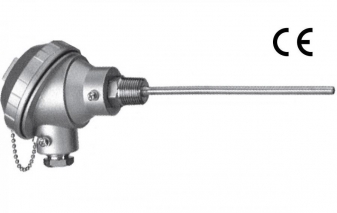Thermocouple reference equipment provides high accuracy monitoring by eliminating the need for cold junction compensation in thermocouples, a major cause of measurement errors. Thermocouples are a temperature-measuring devices formed by the junction of two dissimilar metals. A thermocouple produces a voltage proportional to the difference in temperature between the hot junction and the lead wire (cold) junction. Since the measurement is of the temperature difference between the two junctions, it is a relative reading. To make a more useful absolute reading, a reference sensor is set to and placed next to the cold junction. This is referred to as cold junction compensation.
Though cold junction compensation makes thermocouple readings more useful, they can distort readings by 1°C, or more. In thermocouple reference equipment, a controlled reference temperature, usually 0°C, replaces the cold junction compensation. The accuracy when using reference equipment can be as high as ±0.05°C, much better than standard thermocouple set-ups and there is no long-term drift.
Thermocouple reference equipment is integrated into existing monitoring systems and, depending upon the model, can monitor dozens (or more) of thermocouples.
Temperature Calibration
Temperature is the most commonly measured parameter in commercial and industrial settings. Industries as diverse as food processing, pharmaceuticals, cold storage, paper manufacturing, and others absolutely rely on process temperatures being within a certain range. To maintain accuracy, calibrating temperature monitoring equipment is necessary.
Measuring temperature involves a wide range of specialty sensors such as thermocouples, thermistors, resistive temperature detectors (RTDs), infrared (IR) sensors, bimetal thermometers, and others. These sensors produces an electrical output such as resistance, millivolts or milliamps which correspond to the temperature. These output signals are sent to a readout or controller where they are displayed or used to control a process function.
When discussing temperature calibration it’s important to note that output of the temperature sensors, themselves, cannot be adjusted. Instead, the controller or readout is adjusted to account for the inaccuracy of the sensor.
Calibration is a comparison between two devices. The first device is the unit to be calibrated, often called the unit under test. The second device is the standard, which has a known accuracy. Using the standard as a guide, the unit under test is adjusted until both units display the same results while exposed to the same temperature. Typically, calibration of an instrument is checked at several points throughout the calibration range of the instrument.
Not all standards are created equally. While all standards have a known accuracy, there are some—known as primary standards— that are the highest level of accuracy for a specific parameter. Primary standards achieve their high accuracy by relying upon measurement technologies using fundamental physical constants that do not drift such as the triple point of water. These fixed values minimize uncertainty, making primary standards the most accurate calibration tools.
ITS-90
Temperature calibrations are done in accordance with The International Temperature Scale of 1990. ITS-90 is the legal temperature scale that establishes a number of fixed point temperatures that can be used as reference values. The purpose of which is to define procedures for calibrating temperature equipment in such a way that the values of obtained are precise and reproducible, while at the same time approximating the corresponding thermodynamic values as closely as possible.
Traceability
To improve the quality of a calibration to levels acceptable to outside organizations, it is generally desirable for the calibration and subsequent measurements to be traceable to internationally recognized standards. Establishing traceability is accomplished by a formal comparison to a standard which is directly or indirectly related to national standards ( such as NIST in the USA), international standards, or certified reference materials.
Temperature Calibrator Specifications
There are three specifications that are of extreme importance when selecting a temperature calibrator. Understanding these specifications and their implications will go a long ways towards helping you select the best calibrator for your needs.
Accuracy: An expression of how closely a measured value agrees with the true or expected value of the quantity of interest (NCSL glossary). For temperature calibrators, accuracy is the relationship between the instrument’s display temperature and the actual temperature of calibration well. Accuracy is improved by regular calibrations to a traceable standard.
Stability: The tendency of an attribute to remain within tolerance (NCSL glossary). When a calibrator reaches its set-point, there is some fluctuation in temperature as the unit tries to maintain that temperature. That fluctuation can influence calibrations. Stability adds to accuracy in determining overall system uncertainty.
Uniformity: Temperature homogeneity of the heat source throughout the test zone. All calibrators have slight temperature differences from the bottom of the of the test well to the top as well as from the middle of the test well outward. A few simple strategies allow users to place probes in such a way as to minimize uniformity errors.
Things to consider when selecting a temperature calibrator:
- What type of electrical signal does it output?
- Do I need to calibrate sensors or just temperature displays?
- Which is more important? Speed to change temperatures or doing multiple probes at a time?
- How deep does the dry block or liquid bath need to be?
- What are the physical characteristics (size, shape) of the sensor?
- Over what temperature range is it used?
- And what accuracies are relied on over those temperatures?
- Must the calibrations occur in a laboratory or can they be done in the field or even in-situ?
dpstar is the leading supplier and manufacturer in Malaysia. We are one of the largest distributor throughout South East Asia. For more inquiry and info about us, don’t hesitate to visit our website.Alternatively if you have a bespoke requirement please don’t hesitate to call we have experienced engineers and staffs to help you according to your needs.






